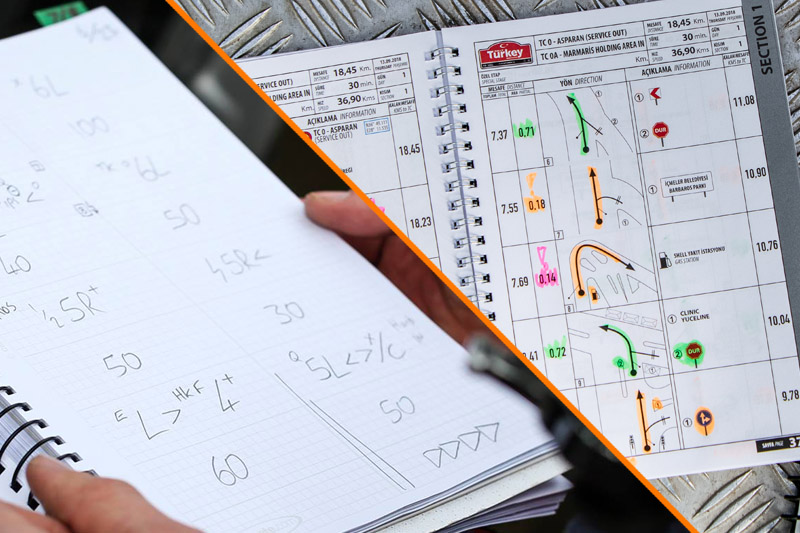Co-driver calls notes via a road book and self made pace notes to tell the rally driver about the course ahead. The ones most used are as follow:
Pace notes en road book example

Numbered corners
6
The fastest of the numbered corners. Can often be taken at full throttle or with a slight throttle lift.
5
Slower than a 6, a 5 will almost certainly require a lift of the throttle on approach.
4
Slower again, 4's require a careful approach. You will need to take considerable speed out on approach.
3
A 3 is a slightly tighter 4, and the difference between the two is dificult to perceive for new drivers. 3's and 4's are arguably the biggest challenge when learning, since taking out too much speed when entering the corner is a common source of lost time for beginners.
2
2 corners are definitely slow, approach with caution.
1
The slowest of the numbered corners, a 1 requires players to slow their cars right down when approaching.
Other corner types
Flat
A section or gentle bend that can be taken with ease at full throttle.
Hairpin, Acute Hairpin
Corners that form an angle smaller than 90 degrees fall lower than the numbering scale. These require a slow approach, and as your skills grow you can experiment with handbrake turns and Scandinavian Flicks to save time.
90, Square
A square angled corner, commonly found on road stages.
Chicane
A quick succession of opposite corners. Plan your entry angle carefully to maximize your speed through chicanes.
Various other calls
Caution
A hazard is ahead. New or inexperienced drivers should reduce their speed to avoid colliding with a roadside object or going off the road.
Tightens
A succession of corners that gets tighter. For example, 'left 4 tightens 2' begins as a 4 and ends as a tighter and slower 2.
Rock/Tree/Logs, In, Out
Roadside objects that you could collide with. For example, 'left 3 rock in' means there is a rock at the inside (apex side) of the corner.
Narrow(s)
The course becomes narrower (tighter left to right) ahead.
Unseen
A corner or object can't be seen from the normal approach angle. For example, 'right 3 into unseen'.
Hairpin Right/Left
Means that you should be aware of a hairpin when exiting the preceding right or left hand corner.
Over Crest
A distinct crest in the road lies ahead. This can often obstruct your view of upcoming corners.
Jump
The car will become airborne when driving over an upcoming crest in the road.
Bump(s)
A rough section that can upset the car's balance. Use caution if the area precedes a corner.
Opens
The road will become wider ahead. This gives you more opportunity for a faster corner exit speed.
Maybe
The road ahead has different possibilities, for example, 'jump maybe' means the car may or may not get airborne depending on how fast you exit the previous corner.
Keep Right/Left/Middle
The fastest or safest driving line is achieved by placing the car on a certain area of the road as you proceed.
Cut, Don't Cut, Small Cut, Big Cut
Hazards ahead may prevent or hinder cutting (don't cut, small cut), or at corners with open apex areas will offer more of a chance to cut (cut, big cut).
Over bridge, Through Gate
A gate or bridge is ahead.
Through Water
standing or flowing water is ahead on the track. This will commonly slow the car dramatically, so aim for the narrowest part of the water if possible.
Tarmac, Ice, Dirt
The road surface ahead will change.
50, 80, 100 etc.
A distance of road. For example, '30, and left 5' means that a straight section of road 30 meters long precedes the upcoming left-handed corner
Junction
Two roads intersect ahead.
Short, Long, Very Long
Refers to an unusually short or long corner.
Brake, Hard Brake, Slow
Advanced warning that you'll need to slow the car considerably to successfully take subsequent corners.
|